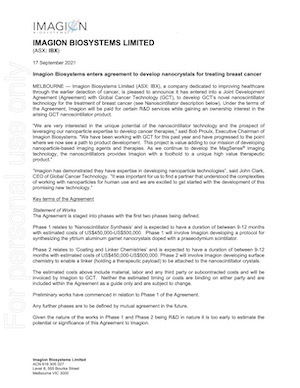 Further to the announcement made on 13th August 2021, Imagion Biosystems Limited provides this supplementary announcement in relation to the agreement with Global Cancer Technology (GCT).
Further to the announcement made on 13th August 2021, Imagion Biosystems Limited provides this supplementary announcement in relation to the agreement with Global Cancer Technology (GCT).
Imagion Biosystems enters agreement to develop nanocrystals for treating breast cancer
Imagion Biosystems is pleased to announce it has entered into a Joint Development Agreement (Agreement) with Global Cancer Technology (GCT), to develop GCT’s novel nanoscintillator technology for the treatment of breast cancer (see Nanoscintillator description below). Under the terms of the Agreement, Imagion will be paid for certain R&D services while gaining an ownership interest in the arising GCT nanoscintillator product.
“We are very interested in the unique potential of the nanoscintillator technology and the prospect of leveraging our nanoparticle expertise to develop cancer therapies,” said Bob Proulx, Executive Chairman of Imagion Biosystems. “We have been working with GCT for this past year and have progressed to the point where we now see a path to product development. This project is value adding to our mission of developing nanoparticle-based imaging agents and therapies. As we continue to develop the MagSense® imaging technology, the nanoscintillators provides Imagion with a foothold to a unique high value therapeutic product.”
“Imagion has demonstrated they have expertise in developing nanoparticle technologies”, said John Clark, CEO of Global Cancer Technology. “It was important for us to find a partner that understood the complexities of working with nanoparticles for human use and we are excited to get started with the development of this promising new technology.”
Key terms of the Agreement
Statement of Works
The Agreement is staged into phases with the first two phases being defined.
Phase 1 relates to ‘Nanoscintillator Synthesis’ and is expected to have a duration of between 9-12 months with estimated costs of US$450,000-US$500,000. Phase 1 will involve Imagion developing a protocol for synthesizing the yttrium aluminum garnet nanocrystals doped with a praseodymium scintillator.
Phase 2 relates to ‘Coating and Linker Chemistries’ and is expected to have a duration of between 9-12 months with estimated costs of US$450,000-US$500,000. Phase 2 will involve Imagion developing surface chemistry to enable a linker (holding a therapeutic payload) to be attached to the nanoscintillator crystals.
The estimated costs above include material, labor and any third party or subcontracted costs and will be invoiced by Imagion to GCT. Neither the estimated timing or costs are binding on either party and are included within the Agreement as a guide only and are subject to change.
Preliminary works have commenced in relation to Phase 1 of the Agreement. Any further phases are to be defined by mutual agreement in the future.
Given the nature of the works in Phase 1 and Phase 2 being R&D in nature it is too early to estimate the potential or significance of this Agreement to Imagion.
Intellectual Property
Any intellectual property (or product) created as a result of the Agreement will be considered jointly owned by Imagion and GCT. Both parties shall own the patent rights and know-how collaboratively regardless of inventorship.
Termination
The Agreement can be terminated by either party upon six months prior notice. Imagion has the right to terminate the agreement within six months should GCT breach any material obligations and fails to remedy any breach within 45 days.
About Nanoscintillators
The nanoscintillator technology, also known as scintillating nanocrystals, has been licensed by GCT from the University of California San Diego. Scintillators are nontoxic minerals and rare earth elements that emit photons (light) when activated by a low dose of gamma radiation. Photocleavable linkers release a drug payload when exposed to the small burst of light from the scintillating photons. Since the drug molecules are inactive while linked to the nanoparticle, the nanoscintillator technology enables a controlled release of the therapeutic agent. This next generation approach, known as x-ray induced photodynamic therapy, has the potential to deliver a more localized and effective dose of drug product to treat cancers because x-rays can penetrate deep tissue. There are more than 400 dedicated stereotactic radiosurgery systems in the US that could be used in combination with the nanoscintillator therapy.
Please click to review the full announcement on ASX.

